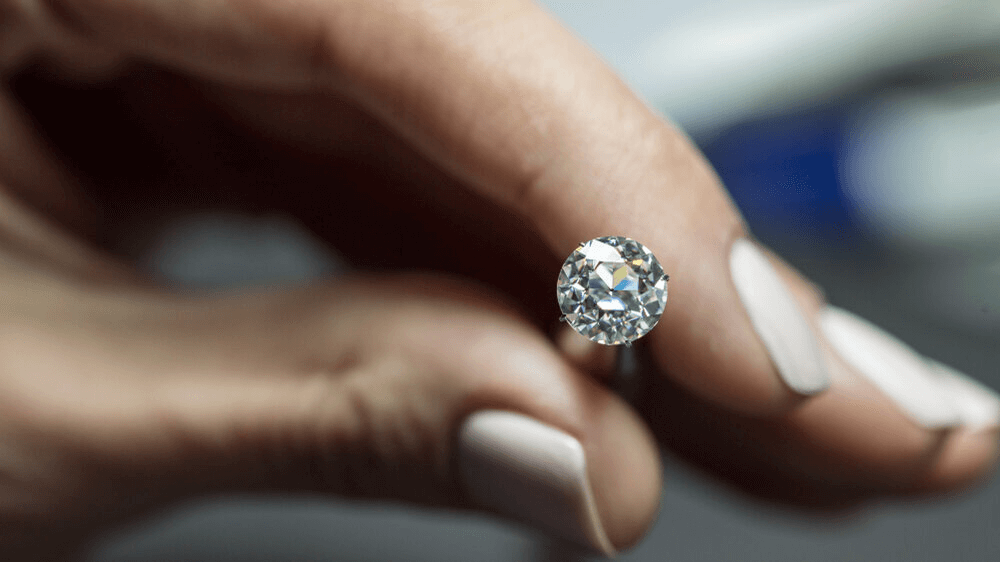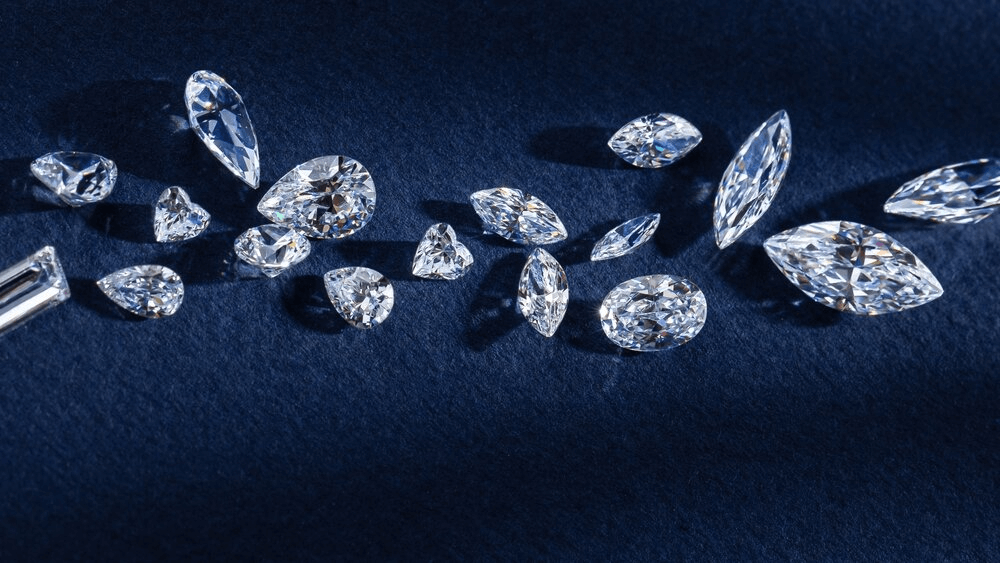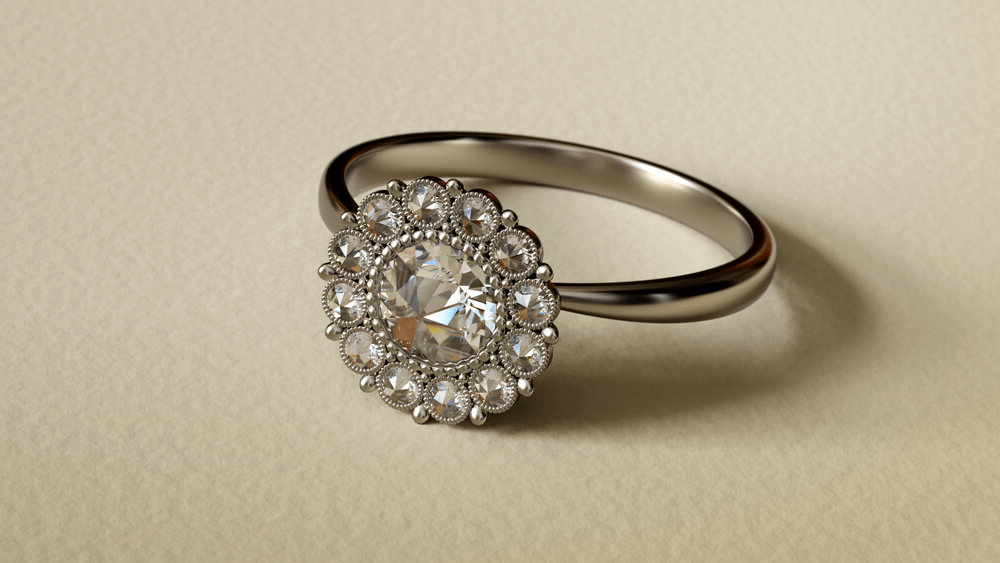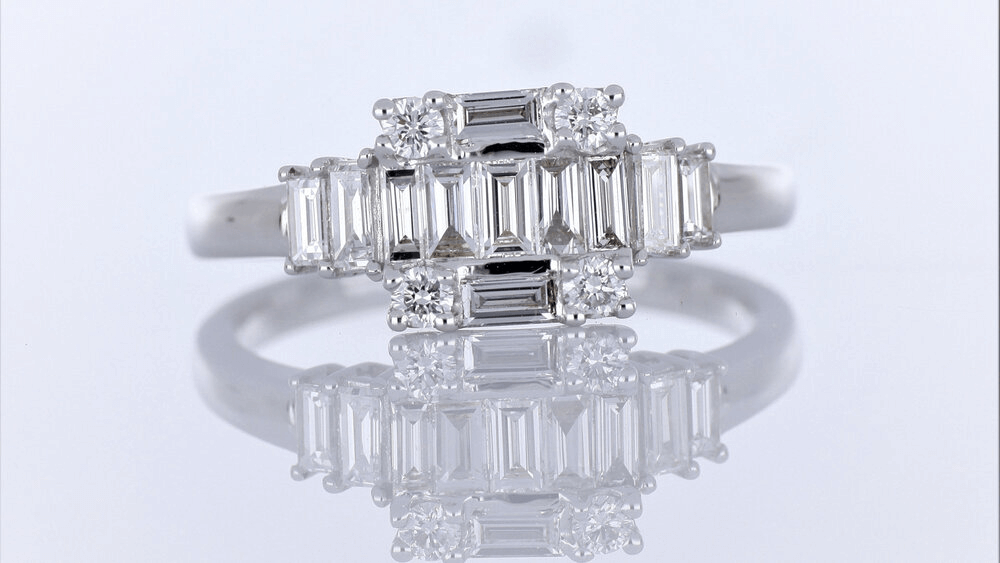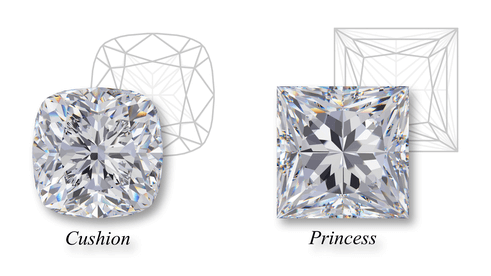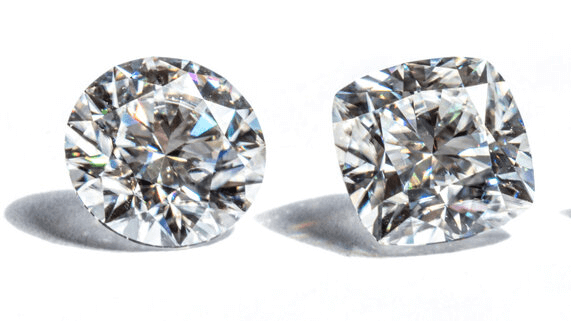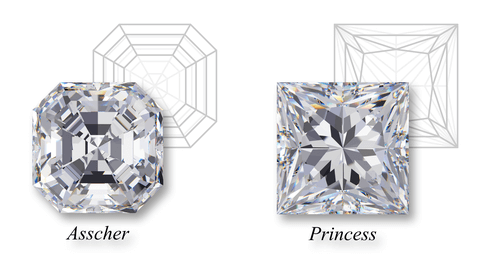Unlock the Secret to Oval Cut Diamonds

By Gary A.

Edited by Olivia H.
Published Apr 19, 2021
Edited on Mar 31, 2025
The elegance and versatility of an oval cut diamond make it a favorite for those seeking a timeless, sophisticated engagement ring that stands out without being too bold.

- 7 Quick Tips for Buying an Oval Cut Diamond Engagement Ring
- Introduction
- Oval Diamonds: The Basics
- A Brief History of Oval Cut Diamonds
- The Charm of Oval Cut Engagement Rings
- Oval Diamond Cost Considerations
- Choosing an Oval Cut Diamond For Your Engagement Ring
- Oval Cut Diamonds Pros and Cons
- Our Expert Take
- 10 FAQs
Before we dive deeper into the specifics, here are some practical tips to help guide your decision-making process:
7 Quick Tips for Buying an Oval Cut Diamond Engagement Ring
- Tip 1: Ideal Ratio Range: For oval cut diamonds, the ideal aspect ratio (length to width) typically ranges between 1.35 to 1.50. This ratio ensures a balanced, aesthetically pleasing shape. Diamonds outside this range may appear too narrow or too wide.
- Tip 2: Symmetry Check: Examine the symmetry of the oval cut carefully. Both halves of the diamond should mirror each other perfectly. Asymmetry in oval diamonds can significantly affect the stone’s overall appearance and light performance.
- Tip 3: Minimizing Bowtie Visibility: The bowtie effect is common in oval diamonds. While a complete absence is rare, look for a diamond where the bowtie is less prominent. Check the stone under various lighting conditions to assess its visibility.
- Tip 4: Complementing the Hand: Choose a length-to-width ratio that complements the wearer’s finger. Longer ovals can make short fingers appear more elongated, while wider ovals can look more proportional on longer fingers.
- Tip 5: Focus on Cut and Brilliance: While color and clarity are important, the cut quality of an oval diamond greatly influences its sparkle and brilliance. Choose a well-cut diamond that reflects light effectively, ensuring maximum brilliance.
- Tip 6: Color and Clarity Selection: Oval diamonds can highlight color more than round cuts. Consider a higher color grade if colorlessness is a priority. In terms of clarity, select a diamond that appears clean to the naked eye, even if it has minor inclusions under magnification.
- Tip 7: Balancing Carat and Appearance: Larger carat sizes in oval diamonds create a significant visual impact, but remember that carat weight also affects price. Balance your preference for size with your budget, keeping in mind that oval cuts often appear larger than their round counterparts of the same carat weight.
Now that you’ve got these practical tips, use Jeweler AI below to find the perfect engagement ring that suits your style and budget:
Introduction
The Oval cut diamond is one of those evergreen cuts that needs no real introduction. Like the Round, it’s capable of doing all the talking for itself – and convincing many shoppers that it’s the perfect choice for them. But, unlike the round, it’s a great shape to consider if you’re looking to stray from ‘the norm’ without going too far in the opposite direction.
For this reason, the Oval is a sort of ‘have your cake and eat it too’ kind of shape, since you get the versatility and timelessness of the Round Brilliant, but a slightly more unique shape (it is, after all, a lot less popular), and one that looks significantly bigger face-up than the Round.
Obviously, there’s a lot more to know about the Oval cut than that – but extolling the virtues of this classic cut is certainly a great place to start…
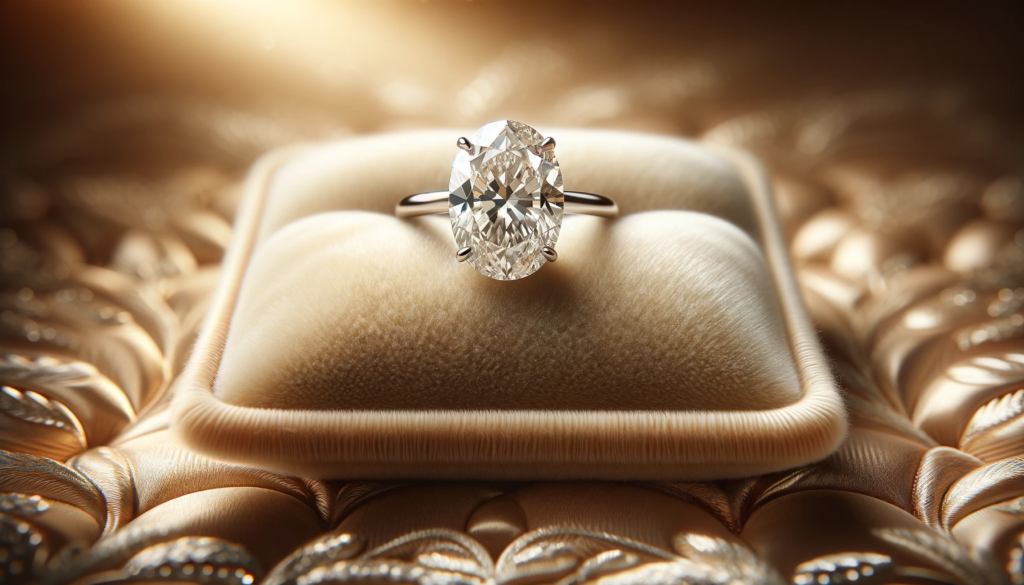
Oval Diamonds: The Basics
As the name would suggest, an Oval cut diamond features a round, elongated shape with no straight edges or harsh points.
The Oval cut diamond is a modified brilliant cut. It’s a cross between a Round Brilliant and a Pear shaped diamond, but without any asymmetries or pointed corners. For this reason, it is also known as a ‘Modified Round Brilliant’. It contains 58 facets – the same number as a round cut – with the culet included.
Its silhouette is very similar to the Victorian ‘Rose cut’, which, these days, has been pushed far out of the spotlight by the modified brilliant cuts. The cut prevents the diamond from doing any real sparkling and, while charming, can easily disappoint within an engagement ring. These days, shoppers looking to evoke that same Victorian elegance tend to opt for the Oval instead.
As a result of that brilliant facet pattern, an Oval cut diamond has excellent sparkle and fire. It also has a different weight distribution to the Round, which can prove to be a major selling point for many shoppers looking to create the most impressive engagement rings possible – but more on that below.
A Brief History of Oval Cut Diamonds
The modern Oval cut was created by Russian cutter, Lazare Kaplan, in the 1960’s, although ovals were introduced into the diamond industry over 200 years ago. This ‘newest’ version, however, offers a far greater degree of sparkle than the designs that came before it, creating a stone that is far more beautiful and symmetrical.
Inarguably, one of the most well-known diamonds in the world – the Koh-I-Noor, or ‘mountain of light’ – has featured an Oval cut since the mid-nineteenth century. Weighing 105.602 carats, the diamond is now in the position of Queen Elizabeth II and resides in the Tower of London. Over the years, it has drawn crowds of thousands to come and gaze upon it – and that tremendous sparkle offered by the Oval cut.
In more recent years, Oval cut diamond engagement rings have proven themselves to be incredibly popular with royalty and celebrities and can be found on the fingers of Princess Kate Middleton, Blake Lively, Serena Williams and Katy Perry, who wears a simple Oval cut diamond on a pavé shank, similar to this Oval Pavé Engagement Ring.
The Oval Diamond: A Timeless Classic
Oval diamonds have been around (in various forms) for centuries, and their shape is simple enough that they will never appear dated or ‘out of fashion’.
Some shapes are capable of looking fresh and modern throughout the decades – or, in the case of the Oval, centuries. There are few shapes as versatile as a well-cut oval, and whether your engagement ring winds up looking vintage or contemporary, flashy, or understated, is entirely down to the ring design.
For instance, take a look at this decadent Oval Halo Engagement Ring in Platinum. The combination of the halo and the Oval cut diamond is evocative of an opulent Victorian mirror, but the bright sheen of the platinum brings the ring into the 21st century and keeps it from looking decidedly ‘vintage’.
This Oval Cathedral in Rose Gold creates a sense of modern romance thanks to the combination of blushing rose gold and the classic Oval cut, but with enough subtlety that it will continue to look fresh and elegant as the decades roll by.
So, yes, the Oval is classic – but don’t confuse that with ‘antiquated’ or ‘old fashioned’.
The Charm of Oval Cut Engagement Rings
It should come as no surprise that the Oval cut creates plenty of beautiful diamonds, but how do they compare to other, more popular cuts once they have actually been placed within an engagement ring setting? Here’s what you need to know…
The Popularity of Oval Diamonds
Offering a modification on the super popular Round Brilliant, the Oval is one of the most popular diamond cuts for engagement rings today.
All of the modified brilliant cuts enjoy their fair share of popularity among couples. Some, like the Pear, tend to drift in and out of fashion as the years (and trends) pass by, but others are capable of standing their ground – of offering something that every new generation of brides- and grooms-to-be find very hard to say ‘no’ to.
Of course, no diamond cut comes anywhere close to rivalling the Round Brilliant in terms of popularity. The Oval is, however, commonly regarded as the second most popular cut out there for engagement rings.
But, like the Round, the Oval is versatile enough that it’s still possible to use it to create a unique engagement ring.
Oval Diamonds and Light Performance (Sparkle)
Their status as a modified brilliant is a result of their facet structure, which closely resembles that of the Round Brilliant – the most sparkly cut of them all.
The Oval will sparkle a little less than the Round, simply because no other cut is quite capable of rivalling it. But, provided you pick an Oval with a very high quality cut, no visible inclusions, and no major ‘bow ties’ (more on that below), you will be treated to a stunning light performance of fire, brilliance and scintillation.
Remember, however, that the ring setting matters to the amount of sparkle a diamond is able to create. Blocking light using bulky settings, like the bezel, will impair its ability to reflect and refract light.
Oval Diamonds Face-Up Appearance
The Oval is not only elongated – which creates the illusion of a greater size overall – but its proportions mean that much more of its weight is spread across its surface area, rather than hidden within the pavilion (lower portion).
As we mentioned above, this is a selling point for many shoppers who may have originally had their eye on the Round Brilliant. It simply means that you essentially get ‘more’ – or, at least, the illusion of more – for your investment, and that you don’t need to stray into the super-expensive carat weights to get a truly impressive diamond.
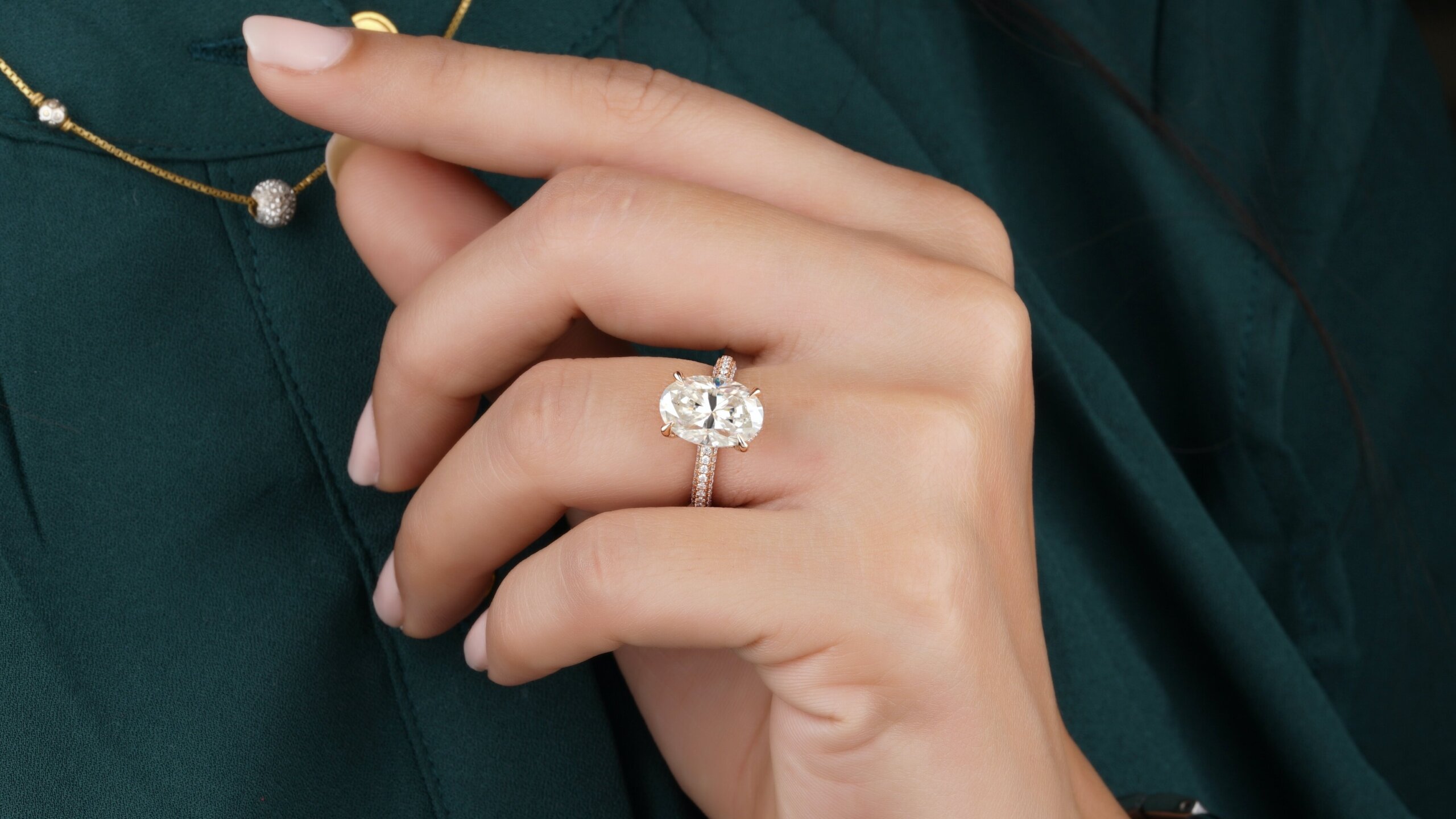
How Big is a 1 Carat Oval Diamond?
The exact measurements of any diamond depend on its proportions, but a well cut Oval will measure approximately 7.7 mm by 5.7 mm.
In our guide to choosing an Oval diamond, we’ll go into a lot more detail about finding the right proportions. For now, however, it’s important to understand that a poorly proportioned diamond could totally ruin your engagement ring, and appear a lot lower in quality – even to an untrained eye.
So, if you find an Oval with a much larger surface measurement, the fact that it looks considerably bigger than other Oval diamonds of the same carat weight shouldn’t be seen as a ‘great find’. In fact, the polar opposite is true.
Why? Because a diamond that looks larger on top will, of course, be lacking a considerable amount of weight in its lower portion – the pavilion. And, while the pavilion is largely obscured by the ring setting, it is vital to ensuring that refracted light takes the right ‘path’ through the diamond.
Without it, the diamond will appear lifeless. It will be dull and lacking in the fire and brilliance that we all want to capture within our engagement rings.
What an Oval Diamond Says About its Wearer
Wearers of the Oval are elegant, and classic, and boast excellent attention to detail.
It really is difficult to imagine any of the modified brilliants replacing the Oval as the most sophisticated and timeless cut out there. Many jewelers regard it as a near-equal to the Round which, if you’ve done your research, you will know as the most esteemed and beloved cut in the diamond world.
Nevertheless, don’t fall into the trap of thinking that the Oval is only suited to one particular type of person, or style. It’s about as versatile as they come and can be dressed up (or down) using your ring design to suit whoever is intended to wear it.
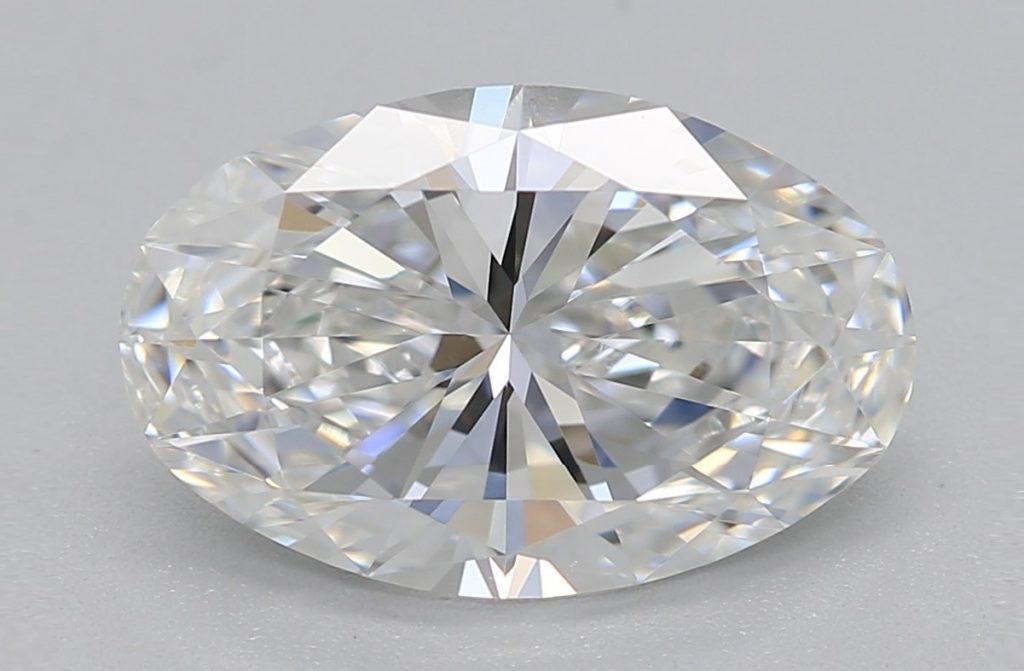
Oval Diamond Cost Considerations
We all know that beauty and precision come at a premium, but there are also plenty of ways to tailor your chosen ring (and cut) to your price point. Here’s what you need to know.
Factors Contributing to Oval Diamonds’ Higher Cost
While diamond cuts are one of the more expensive shapes, they’re still considerably less expensive than the Round Brilliant – and you don’t need to pay a premium for an excessively good quality stone.
Per carat, you save a considerable amount of money simply by picking an Oval, rather than a Round Brilliant of the same quality. Typically between 25% and 30%.
What this means is that you may be able to aim for a higher carat weight than you otherwise would – but never at the expense of clarity, color or cut.
We’ve hinted that there are ways to save money, and there are. You don’t need to pick out a VVS1 diamond when a VS2 (or even SI1) diamond will do, just as you don’t need an F color diamond (or any of the Colorless grades).
Below, we will provide more a detailed rundown of the Four Cs – and a few other features – with regard to saving money without losing quality.
The Cost of a 1 Carat Oval Diamond
Expect to pay upwards of $3,000. Diamonds that cost less are likely to feature visible inclusions, noticeable color (yellow), or a poor cut that impairs sparkle. Or, of course, all of the above.
Remember that the price per carat of a one carat diamond is totally different to the price per carat of a two carat diamond. While it may sound confusing, it’s simply down to the fact that, the larger a diamond gets, the more valuable it is considered.
So, if you can find a truly stunning 1 carat Oval cut diamond for $4,500, don’t jump to the conclusion that you will find a 2 carat diamond of the same quality for $9,000.
It’s all about choosing the right features for the right cost – and understanding which grades are worth sacrificing, and which just aren’t…
Choosing an Oval Cut Diamond For Your Engagement Ring
An important factor to keep in mind when choosing an Oval cut diamond is its symmetry. The diamond should have identical sides and neatly rounded edges. Even the slightest amount of disproportion in the oval cut will be easily noticeable.
The classic setting for an Oval cut is the solitaire, but a halo setting adds an additional sparkle that accentuates the diamond. An Oval paired with a vintage setting has a unique style to it.
One thing you need to watch out for is something commonly known as the ‘bow tie effect’, which can interrupt an otherwise beautiful stone…
Demystifying the Bow Tie Effect
A bow tie is caused by an issue with the diamond’s facets, which causes an area of reduced light within the center of the diamond.
This can resemble a twisted ribbon, or a ‘bow tie’, and really impact the appearance of the stone. It is an unfortunate phenomenon most commonly found in elongated shapes, such as the Marquise and Pear cuts, and, of course, the Oval.
It is important to be aware of the potential for this phenomenon, but don’t let it put you off the Oval altogether. At WillYou, checking for bow ties is part of our comprehensive QA process, which we put each diamond through before we list it for sale. That way, you don’t need to worry about this phenomenon ruining an otherwise promising diamond.
The following cut, color and clarity guides should be taken into consideration when choosing an Oval cut diamond:
Oval Cut Diamond Cut Guide
The cut attributes of a diamond contribute to its sparkle, brilliance, and bling. Most knowledgeable buyers would choose attributes from the Excellent – Very Good columns.
| Excellent | Very Good | Good | Fair | Poor | |
| Table % | 55 – 62.9 | 52 – 54.9 or 63 – 65.9 | 51 – 51.9 or 66 – 68.9 | 50 – 50.9 or 69 – 70.9 | <49.9 or >71 |
| Depth % | 58 – 62.9 | 56 – 57.9 or 63 – 65.9 | 53 – 55.9 or 66 – 70.9 | 50 – 52.9 o r 71 – 74.9 | <49.9 or >75 |
| Girdle | Very Thin to Slightly Thick | Very Thin or Thick | Very Thin or Very Thick | Extremely Thin or Extremely Thick | |
| Culet | None | Very Small | Small | Medium | >Medium |
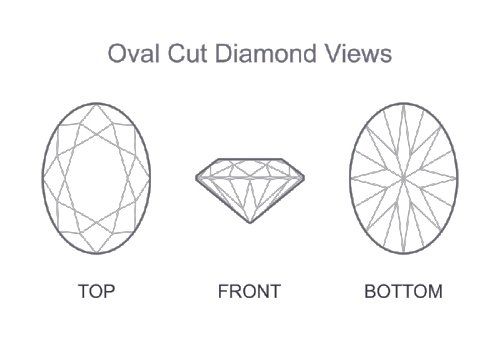
Oval Cut Diamond Length-to-Width Guide
A classic Oval cut has a length-to-width ratio between 1.34 – 1.42.
| Excellent | Very Good | Good | Fair | Poor | |
| Oval | 1.34 – 1.42 | 1.30 – 1.34or1.43 – 1.46 | 1.25 – 1.29or1.56 – 1.60 | 1.20 – 1.24or1.61 – 1.65 | <1.19or>1.66 |
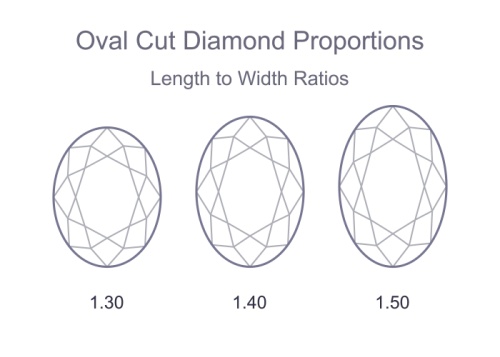
Oval Cut Diamond Symmetry, Polish, Cut and Fluorescence Guide
Our experience suggests that Cut, Symmetry, Polish, and Fluorescence contribute to a diamond’s brilliance so that most buyers will choose Excellent – Very Good and Fluorescence None – Faint.
| Excellent | Very Good | Good | Fair | Poor | |
| Cut | Excellent | Very Good | Good | Fair – Poor | |
| Polish | Excellent | Very Good | Good | Fair – Poor | |
| Symmetry | Excellent | Very Good | Good | Fair – Poor | |
| Fluorescence | None | Faint | Medium | Strong – Very Strong |
Oval Cut Diamond Color Guide
Most buyers prefer size over color hue and will buy a diamond of G color.
| Excellent | Very Good | Good | Fair | Poor | |
| < 0.50 ct | D – G | H – I | J – K | L – M | > N |
| 0.51 – 1.00 ct. | D – F | G – H | I – J | K | > L |
| 1.00 – 2.00 ct. | D – F | G – H | I – J | K | > J |
| > 2.00 ct. | D – F | G – H | I – J | K | > J |
Oval Cut Diamond Clarity Guide
Most buyers prefer size over clarity and will buy a diamond of SI1 Clarity.
| Excellent | Very Good | Good | Fair | Poor | |
| < 0.50 ct | FL – VS2 | SI1 – SI2 | I1 – I2 | > I2 | |
| 0.51 – 1.00 ct. | FL – VS1 | VS2 – SI2 | I1 – I2 | > I2 | |
| 1.00 – 2.00 ct. | FL – VS1 | VS2 – SI1 | SI2 | I1 | > I1 |
| > 2.00 ct. | FL – VS1 | VS2 – SI1 | SI2 | I1 | > I1 |
Oval Cut Diamonds Pros and Cons
There are pros and cons to every diamond shape, Ovals included.
Pros
The Oval cut tends to elongate fingers, making them appear longer and slenderer. They can also create the illusion of a larger size, due to their elongated shape. Ovals look stunning on any hand and can be set with most styles and settings, due to their versatile and timeless appearance.
While they won’t sparkle as much as the Round Brilliant, Ovals do offer a tremendous amount of fire and brilliance – particularly when they are able to draw in as much light as possible. For this reason, we’d recommend the classic Oval Solitaire.
Cons
A con to the Oval cut is its bowtie effect. This is the dark space that can stretch across a diamond’s center. Sometimes the bowtie effect can be easily visible on the diamond, making it less attractive to the buyer.
Our Expert Take
The Oval cut is an excellent choice for so many couples, whether you’re on the search for something elegant and understated, or dazzlingly luxurious – or even evocative of a bygone era.
If you’re looking for a versatile diamond shape – one that will, for many decades, continue to look as fresh and beautiful as it does on the day you get down on one knee – then the Oval is one of the most compelling options out there for you. Like the Round, it’s not subjected to the comings and goings of trends, and it’s not tied to any particular part of history like the ‘Art Deco’ Emerald or the 80’s favorite, the Princess.
It looks just as stunning in a pared-back solitaire as it does when it is surrounded by a dazzling halo, or a complex arrangement of accent stones, and it’ll flatter the finger of anyone lucky enough to wear it.
There are, as always, a few things to show caution towards as you hunt for the perfect diamond. You’ll want to make cut quality your priority, not only to maximize sparkle but also to ensure strong symmetry, and to keep the risk of an obtrusive bow tie to a minimum. You can, however, set your mind at ease by ensuring that you pick a reputable online store that prioritises diamond quality and standards.
Nevertheless, we consider this a strong choice for any shopper.
You can take a look at our full range of GIA graded Oval Diamonds, and then have a look at our online store to see if you can spot something that speaks to you.
10 FAQs
- Q: What is an Oval Cut Diamond?
- A: An oval cut diamond features an elongated shape with brilliant facets, offering a unique blend of the round brilliant cut’s sparkle and a distinct, elegant shape.
- Q: Why Choose an Oval Cut for an Engagement Ring?
- A: Oval cut diamonds provide a distinctive, elegant appearance, often appearing larger than round diamonds of the same carat weight. They also suit various hand shapes and have a classic yet unique appeal.
- Q: How Can I Avoid the Bowtie Effect in Oval Diamonds?
- A: Choose a diamond with a minimal or less visible bowtie effect. Inspect the diamond under different lighting conditions and angles to ensure the bowtie is not overly prominent.
- Q: What Are the Ideal Proportions for an Oval Cut Diamond?
- A: The ideal length-to-width ratio for oval diamonds is generally between 1.35 and 1.50. This range offers a well-balanced and aesthetically pleasing oval shape.
- Q: How Does Carat Size Affect an Oval Diamond’s Appearance?
- A: Oval cut diamonds often appear larger than other shapes of the same carat weight due to their elongated shape. However, larger carat sizes will increase the diamond’s visual impact and value.
- Q: Are Oval Cut Diamonds More Expensive Than Round Diamonds?
- A:Oval diamonds can be less expensive per carat than round diamonds due to their shape and cutting process, offering a balance between size, beauty, and cost.
- Q: How Important is Symmetry in Oval Diamonds?
- A: Symmetry is crucial in oval diamonds as it affects the stone’s balance and overall appearance. A well-symmetrical oval diamond will display even proportions and consistent brilliance throughout.
- Q: Can Oval Diamonds Hide Color or Inclusions?
- A: Oval diamonds can highlight color more than round cuts, so choosing a higher color grade might be necessary. They can mask some inclusions, but clarity is still a significant factor to consider.
- Q: What Settings Work Best with Oval Diamonds?
- A: Solitaire, halo, and pave settings are popular choices for oval diamonds. The right setting depends on personal style and how it complements the diamond’s shape.
- Q: How Does Finger Shape Influence Oval Diamond Selection?
- A: The oval diamond’s elongated shape can make short fingers appear longer. Selecting the right length-to-width ratio helps in achieving a proportionate look that complements the wearer’s hand.
Find your perfect oval cut diamond with Jeweler AI – precision meets personalization.
FOLLOW-UP GUIDE SERIES

